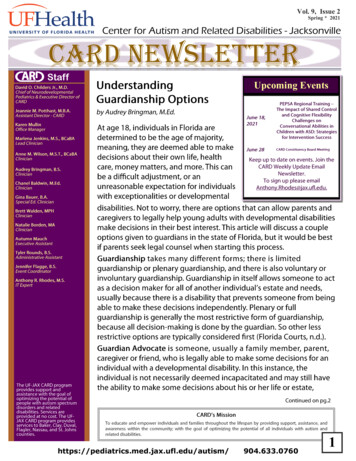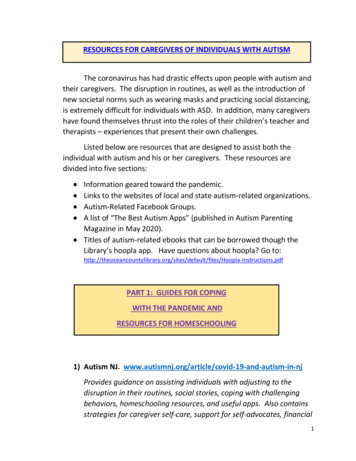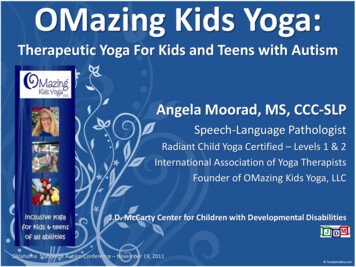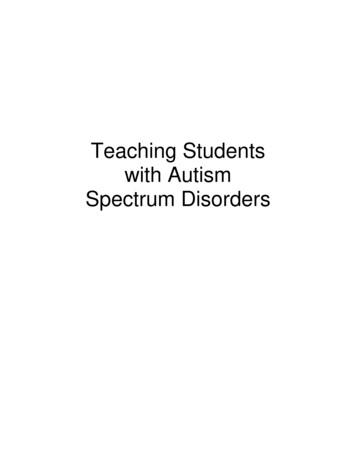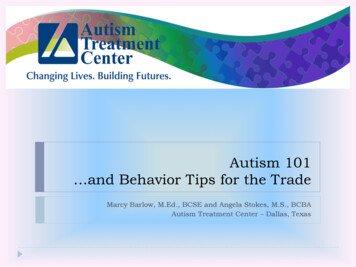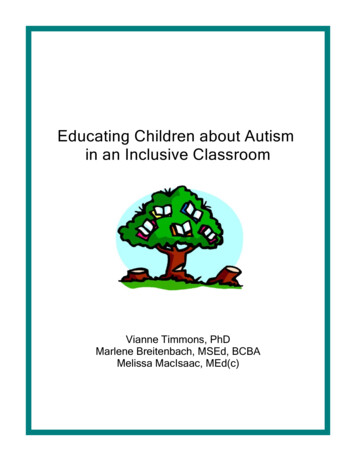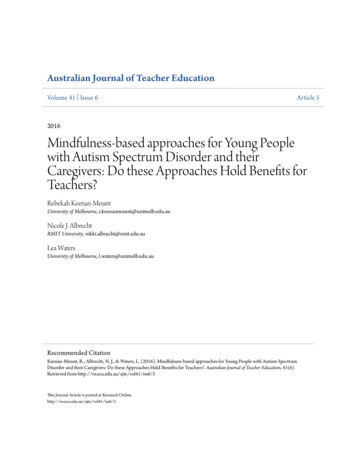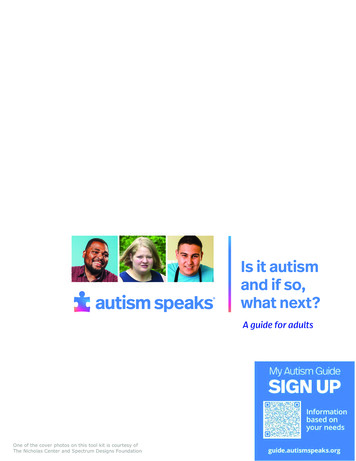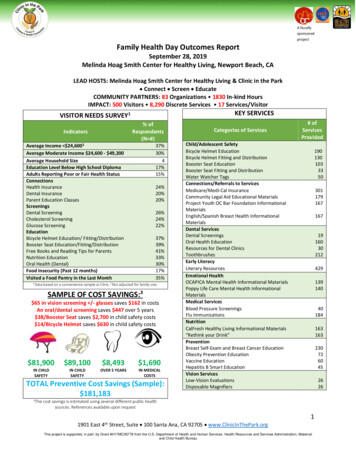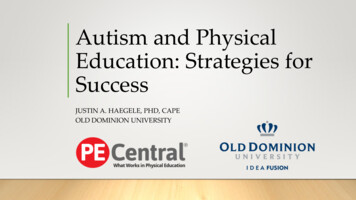
Transcription
Autism and PhysicalEducation: Strategies forSuccessJUSTIN A. HAEGELE, PHD, CAPEOLD DOMINION UNIVERSITY
Food for ThoughtWhen preparing an activity forchildren with autism, a “teachershould plan to use twice as much time,to cover half as much material”Rocco Aiello2007 National APE Teacher of the Year
Outline Characteristics of Autism Effective Communication Strategies Structuring your Classroom for Success
Characteristics of AutismPrior to 2013 Autism spectrum disorders were a collection of five disabilities that shared acommon diagnosis. Differences in how core characteristics were manifested.
Characteristics of Autism Under the DSM-5, the five subtypesof autism have been merged underthe umbrella term Autism SpectrumDisorder.
Characteristics of Autism Persistent deficits in social communication and social interactionacross multiple contexts. Misreading nonverbal interactions Speaking in fragmented sentences Echolalia A lack of eye contact Responding inappropriately to conversations
Characteristics of Autism Restricted, repetitive patterns of behavior, interests, or activities. Overdependence on routines Being highly sensitive to changes in the environment Stereotypic behaviors Repetitive, does not appear to serve a purpose, may be inappropriate for setting. E.g., hand flapping.
Characteristics of Autism Symptoms must be present in the early developmental period. Symptoms cause clinically significant impairment in social, occupational, orother important areas of functioning. Symptoms are not better explained by intellectual disabilities or globaldevelopmental delay. Note: ID and Autism frequently co-occur, to make comorbid diagnoses, socialcommunication should be below that expected for general developmental level.
Characteristics of Autism Children with Autism Spectrum Disorder MAY also display: Behavioral problems Motoric Delays Sensory Issues
Characteristics of Autism DSM-V suggests three levels of severity for ASD based on social communicationlimits and repetitive and/or restricted patterns of behaviors and interests. Level 1: Require support Level 2: Require substantial support Level 3: Require very substantial support
Severity LevelSocial CommunicationRestricted Interests andRepetitive BehaviorsLevel 3Requiring verysubstantialsupportLevel 2RequiringsubstantialsupportLevel 1Requiringsupport1Severe limits in verbal andnonverbal social communicationskills cause severe impairments infunctioning; very limited initiationof social interactions and minimalresponse to social overture fromothers.Preoccupations, fixated ritualsand/or repetitive behaviorsmarkedly interfere withfunctioning in all spheres. Markeddistress when rituals or routinesare interrupted; very difficult toredirect from fixated interests orreturns to it quickly.Marked limits in verbal andnonverbal social communicationskills; social impairments apparenteven with supports in place; limitedinitiation of social interactions andreduced or abnormal response tosocial overtures from others.Rituals and repetitive behaviorsand/or preoccupations or fixatedinterests appear frequently enoughto be obvious to the casualobserver and interfere withfunctioning in a variety ofcontexts. Distress or frustration isapparent when rituals andrepetitive behaviors areinterrupted; difficult to redirectfrom fixated interests.Without supports in place, limits insocial communication causenoticeable impairments. Hasdifficulty initiating socialinteractions and demonstrates clearexamples of atypical or unsuccessfulresponses to social overtures ofothers. May appear to havedecreased interest in socialinteractions.Rituals and repetitive behaviorscause significant interferences withfunctioning in one or morecontexts. Resists attempts byothers to interrupt repetitivebehavior or to be redirected fromfixated interests.
Characteristics of Autism A different look at a spectrum.
Characteristics of Autism While commonly associated with one another, intellectual impairment is notwithin the definition of ASD. Approximately 40% of people with ASD have average or above average intelligence. Approximately 10% display savantism, or extraordinary cognitive ability in a specificarea.
According to the Centers for Disease Control andPrevention (CDC), today 1 in 88 children in the UnitedStates has autism.
Communication
Basic Communication Suggestions Provide short, clear, and precise directions Tell students what to do, rather than what not to do Require communication Give directions in low, firm voice Offer visual cues in addition to spoken words Know the communication style of the student
PECS / Mayer Johnson Symbols The PECS program is a form of augmented and alternative communication thatuses pictures or “icons” instead of words to help children communicate. Mayer Johnson symbols are the icons used in the PECS program and can be usedoutside of the program.
PECS/ Mayer Johnson Symbols Sign In Boards (Transition) Schedule Boards Free Choice Boards First / Then Working for .(Token Economy) Break Card Super Symbols
PECS/ Mayer Johnson Symbols
Electronic Communication DevicesUsed by non-verbal students in order to communicate.Two basic types: Static: Has a fixed display which represents something of desire for the student. Student presses the display and a stored message for that item will sound. Dynamic: Usually a touch screen device which runs specially designed software which providesmultiple layouts and can be specifically designed for the users. Each cell can represent a word, phrase, or symbol which is generated as the cell istouched.
Unfortunately, these devices are not always brought to PE
Electronic Communication Devices “It is dangerous for our students to have such hard objects in such a freeenvironment like physical education” “Electronic devices are expensive, and if students bring them to the gym theywill break them!” “I put a lot of time into making those PECs books, and it isn’t important for themto be brought to the gym”.
Electronic Communication Devices
Social Stories Social stories describe a situation, skill, or concept, in terms of relevant socialcues, perspectives, and common responses in a specifically defined style andformat. The goal of social situations is to allow students to be more comfortable andunderstanding of a social situation. Must be planned out.
Social Stories Steps to creating social stories (Sandt, 2008) Planning: The instructor will determine which student will be using the social storyand which behavior she wants to target. Developing: The instructor will create the story and decide how to present it. Implementation: Instructor uses the story in the classroom.
Social Stories More things to keep in mind: Avoid inflexible language (I will) Try to make stories similar to other stories child comes across at school and at home. Stories should be written in present tense. Usually written in first person narrative.
Social StoriesWhat is the purpose of Social Stories in Physical Education? Highlight positive behaviors Teach routine (John sits on his spot when he enters the gym) Play skills Teach about sports/ activities.
Christy Sloan(APE Teacher in Fairfax County)
Social Stories
CommunicationMost Important Message: Make sure that the communication method that is most comfortable andsuccessful for the student is what you use!
Selecting Activities
Selecting Activities Most important consideration is taking into account the needs and interests oflearners and families. Typically, children with autism have a higher probability of success in individualsports/ activities. But, it should not be assumed that they cannot be successful in team sports.
Selecting Activities Age-appropriateness must also be considered. While motor skills are important to cover in elementary school, they would beinappropriate to teach in a high school setting.
StructureMAKE LIFE PREDICTABLE FOR CHILDREN WITH AUTISM
Structure – 1st Three Steps1.2.3.Observea)Watch how the student interacts with other teachers and students.b)See how the student interacts with equipment, what the can do, what they like or dislike.Interacta)Interact with the students in a ‘low stakes setting’.b)During lunch duty or recess, get to know your student.Assessa)Evaluate the students motor, fitness, or physical activity baseline.b)Evaluate IEP goals.c)Preference evaluation.
Structure Physical structure Scheduling/ Routine Work system Visual structure
Physical Structure Refers to the predictability of the actual layout or surroundings of a person’senvironment. Maintain a ‘home base’ with clearly defined places. Have specific and clearly defined places for particular pieces of equipment oractivities in the gymnasium. Yoga mats for warm-up / exercise routines. Use colors or numbers to guide students through the physical space.
Scheduling/ Routines A schedule or planner is set up which indicates what students aresupposed to do and when it is supposed to happen. Consistent routines allow students to understand one’s schedule andexpectations. Use the same routine each day when entering/ exiting the gymnasium Do not surprise students with new activities without forewarning. Use a visual schedule that demonstrates what sequence activities will come in.
Work System The work system tells the person what is expected of him/her during activities(behavior wise, activity wise), how much is supposed to be accomplished, andwhat happens after the activity is completed. Organized in a way that students have little or no difficulty figuring out what todo.
Visual Structure Visually-based cues regarding organization, clarification, and instructions toassist in understanding what is expected. Physical symbols that represent different activities. A count down timer that tells students when they have completed an activity. Visual ‘stop’ and ‘start’ signals.
Structuring Activities: Example Before performing an activity, communicate to students how long the activitywill take. Just stating that this activity will take 2 minutes will not work. Instead: Use a timer Number of trials (e.g., throw a ball 5 times) Limit the implements to the number of trials (set up 5 balls for 5 trials).
Structuring Activities: Example Provide a clear start and stop sign Symbols Signs Whistle Use color, number, or name matched equipment for each student.
Structuring Activities: Example Instructional Sequences Utilize visuals to communicate instructional sequences, when needed.
A quick aside:Behavior .
Some quick behavior tips Set a timer . When the timer rings students will know the next activity ishappening. Teach students how to request a break card. Speak calmly and factually after a disruption in a class activity. Focus on tasks that need to be accomplished, not the behavior. Teach the acceptance of others’ difference (to kids without ASD).
More quick tips . Minimize inappropriate behavior options Removing objects such as bleachers, equipment bins, or water fountains fromeyesight take away options for misbehaviors. Hang a sheet over larger objects toeliminate them from view. Have a clean gym when students enter – Instead of having every implement thatstudents will use throughout a class spread around a gym, wait to bring equipmentout until it is needed.
DifferentiatingInstructionCREATING LESSONS THAT ARE DEVELOPMENTALLY APPROPRIATE FOR EACHSTUDENT IN THE CLASS WHILE ALSO CHALLENGING EACH STUDENT.
Differentiating InstructionAn Example: Ms. Johnson teaches an integrated physical education class which includes threestudents with autism (one of which, has severe autism). In order to appropriately teach this class, she must create activities that challengethe students without disabilities that are also developmentally appropriate forstudents with severe autism. Ms. Johnson may choose from several types of communication techniques orclassroom structuring ideas in order to do so.
Differentiating Instruction Ms. Johnson may decide to use a video modeling technique to teach a fitnessunit. In doing so, she: Has students without disabilities follow a video model for fitness routines. Has students with autism also attempt to follow the video model, however, if theycannot she (or, a paraeducator) can provide 1 to 1 help. One to one help would also then be available for other students, as well.
Differentiating Instruction Don’t forget!Instruction includes communication, teachers must communicate in theappropriate method for the child, not the other way around.
Music Can act as a positive reinforcement. For many students, listening to music is a strong motivator. Can provide concrete directions for activities Many students enjoy recorded directions (that are predictable) than teacher-leddirections. Can help students focus on task. Songs like the Cha Cha Slide or Cupid Shuffle.BONUS: THESE LINE DANCES GENERALIZE WELL INTOSOCIAL SITUATIONS LIKE WEDDINGS OR SWEET 16s
Resources
Resources
Resources
ResourcesOnline Resources Autism Society www.autism-society.org Autism Speaks – www.autismspeaks.org National Autism Association – www.nationalautismassociation.org
ContactJustin A. Haegele, PhD, CAPEOld Dominion Universityjhaegele@odu.eduTwitter @Justin HaegeleThank you
children with autism, a “teacher should plan to use twice as much time, . Yoga mats for warm-up / exercise routines. Use colors or numbers to guide students through the physical space. Scheduling/ Routines A schedu
